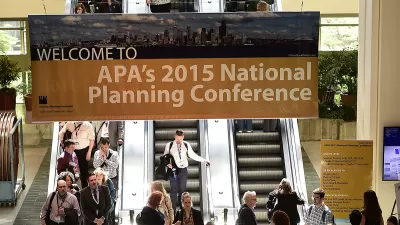A session at the recent APA National Conference in Chicago gathered together the heads of the major built-environment professional organizations to discuss their unique and shared challenges. One subject was on each head's mind: Water.
What is the most critical issue designers don't even know exists? "According to the heads of the major built-environment design organizations, the American Society of Landscape Architects (ASLA), the American Institute of Architects (AIA), and the American Planning Association (APA), it’s water," says Jared Green, who recaps the Presidents Forum held at the recent APA National Conference.
"Water is going to become increasingly scarce. It’s particularly a problem in the United States as many of the highest growth areas are in parts of the country that are already stressed with water shortages. Worldwide, countries are struggling with diminishing ground water resources and some are even worried about water wars. Mitchell Silver, the outstanding (and unfortunately outgoing) president of APA, said 'water is going to make oil look minor league.'” This was among the critical insights provided at the unique gathering of design profession luminaries that included Mark Focht, FASLA and Jeffrey Potter, FAIA.
Other prominent issues confronting each field:
ASLA: "The focus of the next few years will be pushing for land and water conservation, community parks, a national complete streets program, more federal support for green infrastructure, and benefits for small businesses."
AIA: "Potter said the architecture practice was in a state of transformation. He said the world is struggling with how to create 'place-based knowledge in a digital era'....In this new world, architects are increasingly focused on 'high performance places, public health, and disaster mitigation.'”
APA: "With 40,000 members in 90 countries, APA is also concerned about global issues like climate change, population growth, urbanization, and suburbanization....The future then is about 'comprehensive planning' to ensure communities are more 'adaptable and resilient' to changes, whether they are due to population growth, water shortages, economic change, climate shifts, or natural disasters."
FULL STORY: What Is the Most Critical Issue Designers Don’t Even Know Exists?

Alabama: Trump Terminates Settlements for Black Communities Harmed By Raw Sewage
Trump deemed the landmark civil rights agreement “illegal DEI and environmental justice policy.”

Planetizen Federal Action Tracker
A weekly monitor of how Trump’s orders and actions are impacting planners and planning in America.

The 120 Year Old Tiny Home Villages That Sheltered San Francisco’s Earthquake Refugees
More than a century ago, San Francisco mobilized to house thousands of residents displaced by the 1906 earthquake. Could their strategy offer a model for the present?

In Both Crashes and Crime, Public Transportation is Far Safer than Driving
Contrary to popular assumptions, public transportation has far lower crash and crime rates than automobile travel. For safer communities, improve and encourage transit travel.

Report: Zoning Reforms Should Complement Nashville’s Ambitious Transit Plan
Without reform, restrictive zoning codes will limit the impact of the city’s planned transit expansion and could exclude some of the residents who depend on transit the most.

Judge Orders Release of Frozen IRA, IIJA Funding
The decision is a victory for environmental groups who charged that freezing funds for critical infrastructure and disaster response programs caused “real and irreparable harm” to communities.
Urban Design for Planners 1: Software Tools
This six-course series explores essential urban design concepts using open source software and equips planners with the tools they need to participate fully in the urban design process.
Planning for Universal Design
Learn the tools for implementing Universal Design in planning regulations.
Clanton & Associates, Inc.
Jessamine County Fiscal Court
Institute for Housing and Urban Development Studies (IHS)
City of Grandview
Harvard GSD Executive Education
Toledo-Lucas County Plan Commissions
Salt Lake City
NYU Wagner Graduate School of Public Service




























